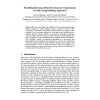Free Online Productivity Tools
i2Speak
i2Symbol
i2OCR
iTex2Img
iWeb2Print
iWeb2Shot
i2Type
iPdf2Split
iPdf2Merge
i2Bopomofo
i2Arabic
i2Style
i2Image
i2PDF
iLatex2Rtf
Sci2ools
IEAAIE
2004
Springer
2004
Springer
Modeling Intrusion Detection Systems Using Linear Genetic Programming Approach
This paper investigates the suitability of linear genetic programming (LGP) technique to model efficient intrusion detection systems, while comparing its performance with artificial neural networks and support vector machines. Due to increasing incidents of cyber attacks and, building effective intrusion detection systems (IDSs) are essential for protecting information systems security, and yet it remains an elusive goal and a great challenge. We also investigate key feature indentification for building efficient and effective IDSs. Through a variety of comparative experiments, it is found that, with appropriately chosen population size, program size, crossover rate and mutation rate, linear genetic programs could outperform support vector machines and neural networks in terms of detection accuracy. Using key features gives notable performance in terms of detection accuracies. However the difference in accuracy tends to be small in a few cases.
Efficient Intrusion Detection | IEAAIE 2004 | Intrusion Detection Systems | Support Vector Machines |
| Added | 02 Jul 2010 |
| Updated | 02 Jul 2010 |
| Type | Conference |
| Year | 2004 |
| Where | IEAAIE |
| Authors | Srinivas Mukkamala, Andrew H. Sung, Ajith Abraham |
Comments (0)

